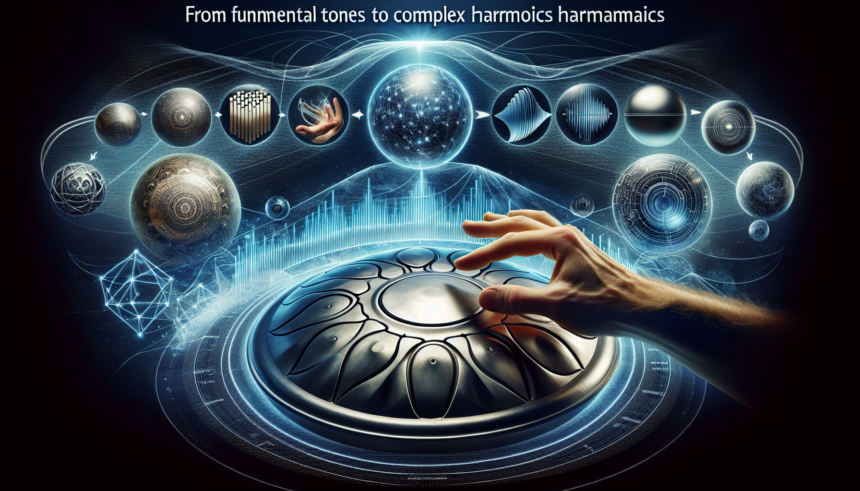<!DOCTYPE html>
<html lang="en">
<head>
<meta charset="UTF-8">
<meta name="viewport" content="width=device-width, initial-scale=1.0">
<title>Handpan Music Evolution</title>
</head>
<body>
<p>The handpan, a captivating and seemingly mystical instrument, has become a symbol of transcendent acoustic experiences. Its enchanting reverberations carry listeners to serene landscapes, forging a swift connection between sound and soul. At the crossroads of rhythmic percussion and melodic invention, handpan music has undergone a remarkable transformation from its initial resonant fundamentals to the intricate tapestry of complex harmonics it produces today.</p>
<p>Understanding the evolution of handpan music requires a journey through time, from the development of the earliest steel pan and related idiophones to the birth of the modern handpan. While this relatively young instrument only came into existence at the turn of the 21st century, its roots and influences span much wider temporal and cultural bounds.</p>
<h2>The Early Beginnings: From Steel Pans to the Conception of the Handpan</h2>
<p>The handpan's evolution begins with its ancestral predecessor, the steel pan. Emerging from the Caribbean islands in the 20th century, specifically Trinidad and Tobago, steel pans were born out of necessity and creativity. Initially crafted from repurposed oil drums, these instruments offered a vibrant, compelling musical expression. Over decades, they grew in complexity and sophistication, inspiring musicians and instrument makers globally.</p>
<p>The steel pan’s growing popularity and the desire for a harmonious instrument that could be played with hands led to the birth of the handpan near the end of the 1990s. Felix Rohner and Sabina Schärer, founders of PANArt in Switzerland, are credited with creating the first handpan, known as the Hang. Their innovation resonated with musicians for its unique, harmonious tones and the tactile experience it provided.</p>
<h2>Birth of the Hang: The Catalyst for an Emerging Musical Revolution</h2>
<p>The introduction of the Hang in 2000 marked a significant turning point. Rohner and Schärer meticulously crafted the instrument by merging the shapes and acoustic properties of both the steel drum and the ghatam, an Indian percussion instrument. The Hang was distinguished by its UFO-like design, intuitive finger-controlled playability, and its hypnotic, resonant tones.</p>
<p>The instrument’s allure quickly garnered a dedicated following, sparking the emergence of a new musical movement centered around these ethereal tones. It paved the way for a global handpan community. Musicians and enthusiasts alike embraced the Hang’s ability to produce complex, soothing soundscapes from a single instrument.</p>
<h2>From Monophony to Polyphony: The Evolution of Musical Expression</h2>
<p>In its early days, handpan music was characterized by a simplistic yet profound musical style, driven by the fundamental notes achievable on rudimentary instruments. These sounds were typically monophonic, emphasizing an intimate and personal connection with the player. As more individuals encountered the instrument, the repertoire began to expand, and musicians experimented with the tonal capabilities of the handpan.</p>
<p>The invention of new handpans encouraged polyphonic explorations, where multiple notes could be played together, allowing for more intricate compositions. Musicians began developing innovative techniques, such as harmonics, muting, and multi-hand playing, enriching the musical possibilities and transforming handpan music into a dynamic fusion of melody and rhythm.</p>
<h2>Technological Advancements and Craftsmanship Enhancements</h2>
<p>The natural evolution of instrument design and craftsmanship over the past two decades has further amplified the handpan's sophisticated sound. Advances in metallurgy, tuning techniques, and ergonomic shaping have allowed for refined tone fields and smoother playability. Artisans have worked diligently to achieve precise consistency in sound production, leading to a rise in customized and varied scales tailored to musicians' preferences.</p>
<p>Additionally, modern handpans incorporate layered sound harmonics and precise overtones, making them versatile instruments capable of producing a wide array of expressive soundscapes. As craftsmanship continues to progress, each instrument now represents a unique sonic identity, blending tradition with modern musical demands.</p>
<h2>The Expanding Influence of Handpan Music Across Genres</h2>
<p>The unique sound of the handpan has transcended its niche origins to influence a broad spectrum of musical genres. From ambient and world music to modern jazz and pop, the handpan provides a bridge between cultures and musical styles. Musicians appreciate its distinct ability to blend, resonate, and enhance acoustic environments.</p>
<p>The digital age has further accelerated this influence, with social media and online platforms serving as compasses to navigate the ocean of diverse handpan performances. Artists like Manu Delago and David Charrier have popularized handpan music by pushing its boundaries and integrating it into ensembles, orchestras, and multimedia projects.</p>
<h2>Global Collaborations and the Modern Handpan Community</h2>
<p>Handpan music is as much about community as it is about individual expression. The global handpan community continues to thrive through collaborative gatherings, festivals, and workshops, offering a space for musicians to share skills, learn from one another, and inspire each other's musical journeys.</p>
<p>Events such as the Hangout UK, PanOz, and the Handpan Festival in France provide enthusiasts with the platform to experience handpan exploration firsthand, fostering a network that celebrates the instrument's limitless possibilities. The blend of traditional, contemporary, and experimental handpan music shared in these spaces emphasizes the communal spirit and shared love for acoustic creativity.</p>
<h2>Conclusion</h2>
<p>Since its inception, the handpan has undergone a transformative journey from its fundamental tones to the complex harmonics that define its modern soundscape. This instrument's evolution showcases the blend of craftsmanship, technological innovation, and broad musical exploration, cementing its place as a beloved medium for both personal expression and collaborative auditory artistry.</p>
<p>The handpan world continues to expand, with new instruments and techniques evolving at an exciting pace. As musicians dive deeper into its capacious sound world, the handpan will undoubtedly continue to influence global music, resonating with its harmonious charm to unite listeners and players from all corners of the globe.</p>
<h2>FAQs</h2>
<ol>
<li><strong>What is a handpan?</strong>
<p>A handpan is a steel musical instrument played with the hands, characterized by its unique, drum-like shape and ethereal sounds. It is renowned for its melodic and harmonic resonances and is used in various musical genres around the world.</p>
</li>
<li><strong>How is a handpan different from a steel pan?</strong>
<p>While both instruments share a common heritage in their development, the key difference lies in their sound production and playing method. Steel pans are played with mallets and produce brighter tones, whereas handpans are played with hands and yield more mellow, melodic sounds.</p>
</li>
<li><strong>Who invented the handpan?</strong>
<p>The first handpan, known as the Hang, was invented by Felix Rohner and Sabina Schärer of PANArt in Switzerland around the year 2000. Their creation brought a new dimension to the world of idiophonic instruments.</p>
</li>
<li><strong>What are the main playing techniques for the handpan?</strong>
<p>Handpan playing techniques range from simple tapping and striking to more advanced methods such as muting, harmonics, and multi-finger rolls. These techniques allow musicians to produce varied sound textures and dynamics.</p>
</li>
<li><strong>Can anyone learn to play the handpan?</strong>
<p>Yes, anyone can learn to play the handpan with practice and dedication. The instrument’s intuitive layout makes it accessible to beginners, while its complexity offers seasoned musicians ample opportunities for creative exploration.</p>
</li>
</ol>
</body>
</html>From Fundamental Tones to Complex Harmonics: The Evolution of Handpan Music

Leave a comment




